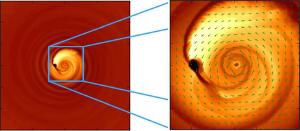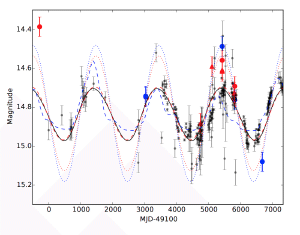Blog
Two Black Holes
in a Gravitational Dance
18 September 2015
 Columbia University
Columbia UniversityIn August I wrote about evidence of a binary supermassive black hole in the center of a galaxy. Now there’s news of another binary in a different galaxy.1
The galaxy in question is PG 1302-102, and the light we see has traveled for about 3.5 billion years. Like the other supermassive binary, this galaxy is also a quasar, so it emits a great deal of light from its central region. The team noticed that this particular quasar varied in brightness rather significantly with a period of about 5 years. This could be the sign of two black holes orbiting each other, but it was hard to be sure. So the team created a computer model of a binary system that could explain the variation. What they found is that smaller black hole should be the one causing the most variation in brightness. As the smaller black hole sweeps around the larger one, it captures more material, causing it to superheat.
 D’Orazio, et al
D’Orazio, et alGiven a period of only 5 years, the smaller black hole would need to be moving at nearly 7% of the speed of light. That’s fast enough that special relativity plays a role. If their model was correct, then there should be an even larger variation in brightness at ultraviolet wavelengths. So the team looked at archive data from GALEX and Hubble, which had observed the quasar in the ultraviolet. What they found matched their predictions. All indications are that PG 1302-102 is a supermassive binary.
What’s particularly interesting about this binary is that the two black holes are quite close, about 2,000 astronomical units apart. That’s really close given that their combined mass is on the order of a billion Suns. Within another few hundred thousand orbits, the two black holes will merge with a brilliance of 100 million supernovae.
D’Orazio, Daniel J., Zoltán Haiman, and David Schiminovich. “Relativistic boost as the cause of periodicity in a massive black-hole binary candidate.” Nature 525.7569 (2015): 351-353. ↩︎